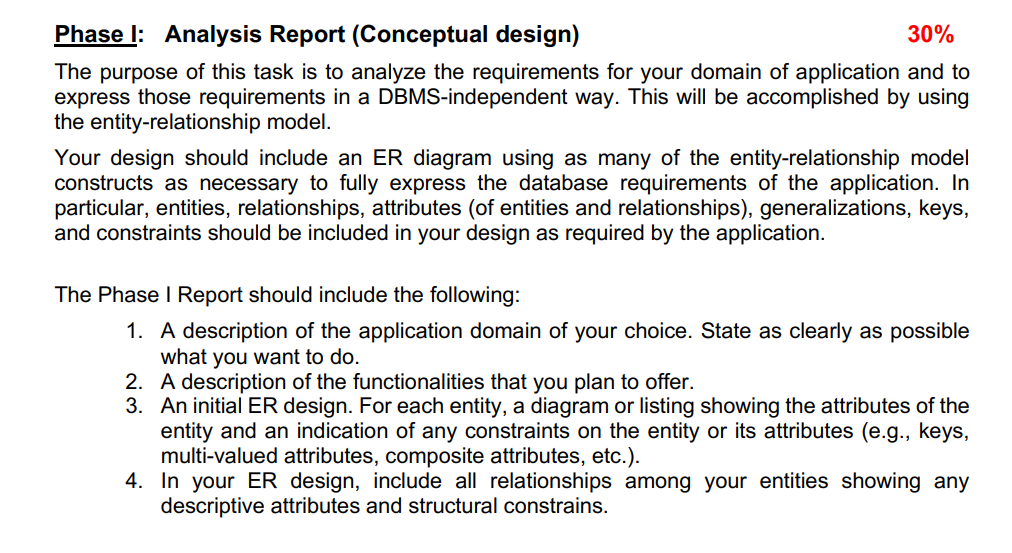We chose Hospital and here something to help
hospital 1. patient : 1. PatientName 2. ID 3. status 4. DOB 5. Gender 6. Address 2. doctor : 1. DoctorName 2. ID 3. specialty 4. DOB 5. Salary 6. Address 3. nurse : 1. NurseName 2. ID 3. Salary 4. Address 4. - employee : 1. EmpName 2. ID 3. Salary 4. Address 5. - appointment : 1. AppDate 2. AppTime 3. AppNumber 4. departmentName 5. AppDuration 6. -room : 1. RoomNo 2. BedNum 3. adviceID 4. location 7. - department : 1. name 2. location 3. number 8. - medicine 1. Code 2. Quantity 3. Price 9. medical record: 1. record id 2. date of examination 3. Status
 This is the Template:
This is the Template:

Phase 1: Analysis Report (Conceptual design) 30% The purpose of this task is to analyze the requirements for your domain of application and to express those requirements in a DBMS-independent way. This will be accomplished by using the entity-relationship model. Your design should include an ER diagram using as many of the entity-relationship model constructs as necessary to fully express the database requirements of the application. In particular, entities, relationships, attributes (of entities and relationships), generalizations, keys, and constraints should be included in your design as required by the application. The Phase 1 Report should include the following: 1. A description of the application domain of your choice. State as clearly as possible what you want to do. 2. A description of the functionalities that you plan to offer. 3. An initial ER design. For each entity, a diagram or listing showing the attributes of the entity and an indication of any constraints on the entity or its attributes (e.g., keys, multi-valued attributes, composite attributes, etc.). 4. In your ER design, include all relationships among your entities showing any descriptive attributes and structural constrains. 1. Introduction In this section give a description of your application domain. 2. Project goals In this section try to describe the goals of your project and the functionalities that you will try to implement. 3. Database Design In this section describe your database design based on the information and the requirements you described in the previous sections. 3.1. Identification of the entity types and their attributes 3.2. Identification of the relationships and business rules 3.3. Entity Relationships Diagram Describe any assumptions you made. 4. References List here the references from which you get the information regarding your application domain. Phase 1: Analysis Report (Conceptual design) 30% The purpose of this task is to analyze the requirements for your domain of application and to express those requirements in a DBMS-independent way. This will be accomplished by using the entity-relationship model. Your design should include an ER diagram using as many of the entity-relationship model constructs as necessary to fully express the database requirements of the application. In particular, entities, relationships, attributes (of entities and relationships), generalizations, keys, and constraints should be included in your design as required by the application. The Phase 1 Report should include the following: 1. A description of the application domain of your choice. State as clearly as possible what you want to do. 2. A description of the functionalities that you plan to offer. 3. An initial ER design. For each entity, a diagram or listing showing the attributes of the entity and an indication of any constraints on the entity or its attributes (e.g., keys, multi-valued attributes, composite attributes, etc.). 4. In your ER design, include all relationships among your entities showing any descriptive attributes and structural constrains. 1. Introduction In this section give a description of your application domain. 2. Project goals In this section try to describe the goals of your project and the functionalities that you will try to implement. 3. Database Design In this section describe your database design based on the information and the requirements you described in the previous sections. 3.1. Identification of the entity types and their attributes 3.2. Identification of the relationships and business rules 3.3. Entity Relationships Diagram Describe any assumptions you made. 4. References List here the references from which you get the information regarding your application domain
 This is the Template:
This is the Template:






